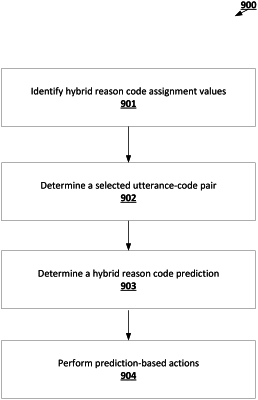| CPC G06F 40/289 (2020.01) [G06N 5/027 (2013.01)] | 20 Claims |

|
1. A computer-implemented method comprising:
identifying, by one or more processors, a plurality of utterances of a document data object;
generating, by the one or more processors and an utterance prediction machine learning model, an utterance markedness likelihood value for an utterance of the plurality of utterances based at least in part on an utterance word embedding representation of the utterance;
generating, by the one or more processors and an utterance-code pair prediction machine learning model, a conditional code-to-utterance assignment likelihood value for an utterance-code pair associated with the utterance based at least in part on (i) the utterance word embedding representation, (ii) a reason code word embedding representation for a reason code of a plurality of reason codes, and (iii) a plurality of normalized attention distributions for the reason code across the plurality of utterances, wherein the conditional code-to-utterance assignment likelihood value represents a predicted probability of assigning the reason code to the document data object based at least in part on the utterance being a most semantically significant utterance for the document data object relative to one or more other utterances of the plurality of utterances;
generating, by the one or more processors and using a prediction machine learning model, a reason code assignment likelihood value for the utterance-code pair based at least in part on the utterance markedness likelihood value for the utterance and the conditional code-to-utterance assignment likelihood value for the utterance-code pair;
determining, by the one or more processors, a reason code prediction based at least in part on the reason code assignment likelihood value, wherein the reason code prediction describes a selected utterance of the plurality of utterances and a selected reason code of the plurality of reason codes; and
initiating, by the one or more processors, the performance of one or more prediction-based actions based at least in part on the reason code prediction.
|